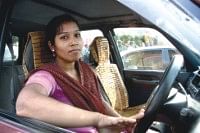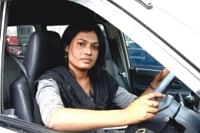|
Trends
Driving-Seat: Revamped
Raisaa Tashnova
The absolute testosterone domination is over, at least on the streets of Dhaka. Though still minimal in number, the women are taking to the driver's seat, literally. We still are taken aback or at least fascinated whenever we notice a female driving but is it really worth a second glance after all?
Hamida Bilquish and Nurunnahar Chowdhury have been driving in Dhaka for a while now. They both admit to being immune to the glaring and ogling they are constantly being subjected to while on the street and even talk about incidents where rickshaw pullers and chauffeurs intentionally created tortuous passages for them to maneuver through.
 |
Photos: zahedul i khan |
 |
Though still minimal in number, the women are taking to the driver's seat, literally. |
“It's like those people (chauffeurs and rickshaw pullers) are testing our competence as drivers” says Nurunnahar Chowdhury, “First I used to get scared and did not know what to do. Every person around the area seemed to be giving me directions and that just got me confused”. Hamida Bilquish, a more experienced driver, says in such situations she just sits there not listening to anyone and waits for the troublemaker to maneuver his way out instead.
Unlike many other controversial subjects of gender equality, this one does not produce a desire for subtlety amidst its opponents. Chauffeurs bluntly and conclusively state that women drivers are a menace on the streets (their words translated exactly). According to them women drivers are too slow and lack the reflex required on the Dhaka streets. They also accuse women drivers of being indecisive (a trait allegedly inherent in all women whether they are driving or not).
To prove his point, a private chauffer relays a story. “Once I was driving through Green Road and the car right ahead of me was being driven by a woman. Now Green Road is filled with rickshaws and you cannot give them space or else you will be stuck as a chain of rickshaws utilises that one tiny gap to pass through. The car in front of me kept leaving space everytime the traffic moved and just slowed us all down.” He said with a look of disgust on his face. “What's more, she slowed down a long way before the signal resulting in all of us missing the green light!”
Such preconceptions, in addition to the gaping, have made it difficult for more women, especially younger women to drive for themselves. Mariam Karim is what you can call a driving school dropout. According to her, the streets of Dhaka are crazy enough without people making it more difficult for her just because she is the wrong gender behind wheels.
“I was afraid that if I get into an accident, the row will not just be about me or my driving skills. Instead there will be a general statement blaming all women and why women should not be driving.” She says when asked why she quit mid-way. She also adds how because of this personal perspective, she has a special respect for women who drive, “I find women driving without any fear to be the ultimate symbol of women's liberation and freedom!”
Whether we fall in the category of disgruntled chauffeurs who fear for their livelihood's extinction or Mariam, an admirer of the rebel drivers, we will all have to fast come to terms with this development. Even the government is now well on their way towards starting buses for women, driven by women. Yes we, the women, have officially entered yet another male-dominated territory.
Copyright
(R) thedailystar.net 2010 |
